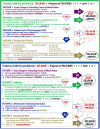Improving Delirium Assessments in Vanderbilt Pediatric and Pediatric Cardiovascular Intensive Care Units
- PMID: 35919397
- PMCID: PMC9278948
- DOI: 10.1097/pq9.0000000000000577
Improving Delirium Assessments in Vanderbilt Pediatric and Pediatric Cardiovascular Intensive Care Units
Abstract
Introduction: Delirium is a disturbance of attention and awareness that represents a change from baseline mental status. Accurate diagnosis of delirium is of paramount importance to improving the management of pediatric delirium in the intensive care unit. Despite ongoing education, inconsistencies in delirium assessments occur. Here, we aimed to determine the extent of the problem and increase compliance with delirium assessments.
Methods: We collected preintervention data to assess baseline compliance of delirium assessments in the Pediatric Intensive Care Unit (PICU) and Pediatric Cardiac Intensive Care Unit (PCICU) at Monroe Carell Jr Children's Hospital at Vanderbilt in November 2020. We executed 2 Plan-Do-Study-Act cycles with different interventions and collected data after each and approximately 1 year after the interventions. The first intervention consisted of virtual lectures on delirium assessments for the nursing staff. The second intervention included an educational handout and a new electronic medical record documentation tool.
Results: Five hundred five individual nurse-patient encounters were assessed and collected throughout the project. The mean compliance of delirium documentation before the interventions was 52.5%. Target compliance after interventions was 70%. Mean compliance was 70% after cycle 1, 78% after cycle 2, and 86% in March 2022.
Conclusions: Using pre- and postintervention data from chart reviews and nurse interviews regarding delirium screenings, we found that interventions targeting nurse education and EMR flowsheet improved compliance with delirium assessment and documentation in the PICU and PCICU. Future work should focus on assessing the clinical implications of this project in diagnosing and treating delirium.
Copyright © 2022 the Author(s). Published by Wolters Kluwer Health, Inc.
Figures





References
-
- Association. AP. Diagnostic and Statistical Manual of Mental Disorders (DSM-5). American Psychiatric Pub.; 2013.
-
- Ely EW, Inouye SK, Bernard GR, et al. . Delirium in mechanically ventilated patients: validity and reliability of the confusion assessment method for the intensive care unit (CAM-ICU). JAMA. 2001;286:2703–2710. - PubMed
-
- Siegel EJ, Traube C. Pediatric delirium: epidemiology and outcomes. Curr Opin Pediatr. 2020;32:743–749. - PubMed
LinkOut - more resources
Full Text Sources
